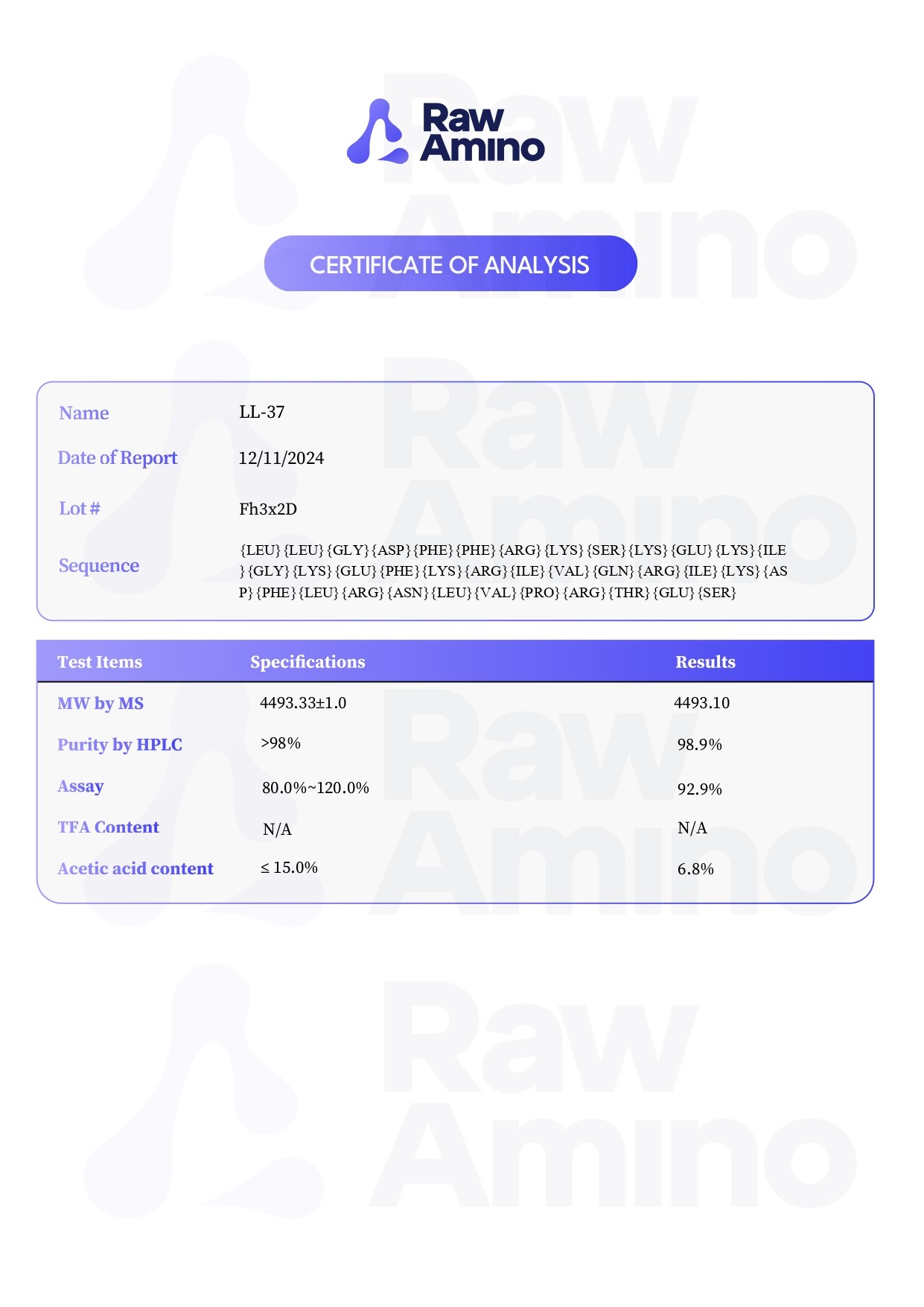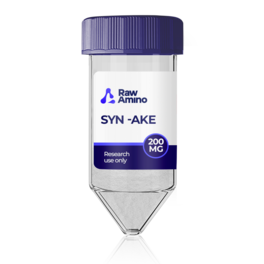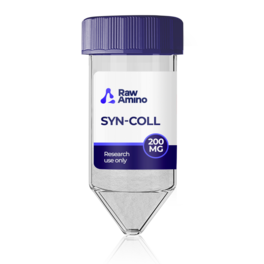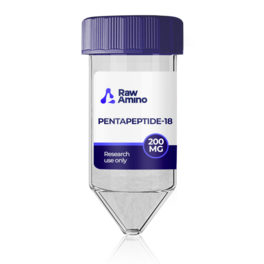
LL-37 – 5MG
$87.00
Discount per Quantity
| Quantity | Discount | Price |
|---|---|---|
| 5 - 8 | 5% | $82.65 |
| 9 + | 10% | $78.30 |
Scientific Overview of LL-37
LL-37 is part of the cathelicidin family, a group of naturally occurring peptides associated with innate immunity and microbial defense. This peptide is produced by specialized immune cells such as macrophages and polymorphonuclear leukocytes and has been widely discussed as a member of antimicrobial peptides (AMPs). These molecules may serve as an early defense line by interacting with bacterial and viral components, while also participating in cellular communication and tissue regulation.
What makes LL-37 noteworthy is its suggested multifunctionality. Beyond its potential antimicrobial characteristics, the peptide has been studied in connection with processes involving inflammation, immune signaling, cancer biology, vascular growth, and tissue repair. Its complex behavior is thought to arise from interactions with both microbial products and host receptors, positioning it as an interesting candidate in the exploration of immune regulation and disease models.
Alternative Names: CAP-18
LL-37 Studies and Research Data
LL-37 Peptide Activity in Intestinal Models
Laboratory studies propose that LL-37 may help maintain epithelial integrity within the gastrointestinal tract. Observations suggest the peptide could influence cellular migration and apoptosis pathways, potentially assisting barrier function during inflammatory conditions. In some models, LL-37 appeared to work alongside defensins to support recovery of intestinal lining, with discussions noting possible interactions with TNF-related pathways. Findings in intestinal cancer models remain mixed, with reports suggesting both supportive and complex outcomes.
Insights from Inflammatory Disease Research
Investigations into autoimmune and inflammatory disease models, such as lupus, arthritis, and psoriasis, indicate that LL-37’s role may depend heavily on the surrounding immune environment. Some studies suggest the peptide can interact with toll-like receptors and cytokine pathways, influencing whether immune activity is heightened or moderated. Rather than showing a fixed role, LL-37 appears to participate dynamically, with reports pointing to possible correlations between peptide levels and disease severity.
Antimicrobial and Barrier Interactions
LL-37 has been proposed to act as an early-response molecule of innate immunity, particularly during skin and mucosal challenges. It may interact with bacterial lipopolysaccharides, potentially destabilizing microbial membranes, while also working with other proteins such as lysozyme. Research also notes a potential role in gastrointestinal ulcer contexts, where the peptide’s expression is elevated in response to immune signaling pathways. This suggests LL-37 may be involved in both microbial interference and regulation of local inflammation.
LL-37 Studies in Respiratory and Lung Conditions
When airborne bacterial components such as lipopolysaccharides are present, LL-37 may participate in immune responses of lung tissue. Some research suggests the peptide might contribute to epithelial recovery and cell proliferation in lung models, particularly in conditions involving toxic dust exposure. While preliminary, these findings point to its potential relevance in respiratory studies involving epithelial repair.
LL-37 Observations in Arthritis Research
Rodent arthritis models have reported high levels of LL-37 within joint tissue. Interestingly, the presence or absence of the peptide did not consistently alter overall disease outcomes, suggesting its role may be secondary or context-dependent. Derivatives of LL-37, however, have been noted to influence collagen preservation and possibly moderate interleukin pathways. This has led some investigators to suggest selective immunomodulatory potential in joint inflammation scenarios.
Vascular and Angiogenesis-Related Findings
Laboratory research with endothelial cells indicates that LL-37 may influence vascular processes by promoting prostaglandin E2 (PGE2) production and supporting angiogenesis. In experimental models, this activity appeared to enhance new blood vessel formation, a process that may impact contexts ranging from tissue recovery to cancer studies. While these findings remain tentative, they highlight LL-37’s possible significance in angiogenesis and epithelial restoration.
Immune Signaling and Receptor Interactions
A growing body of literature discusses LL-37’s interactions with self-nucleic acids and cellular receptors. It has been proposed that the peptide may modulate scavenger receptor activity and facilitate clathrin-dependent endocytosis, triggering immune signaling cascades. This suggests LL-37 could play a role in fine-tuning cellular recognition pathways, contributing to the balance between inflammation and regulation of immune responses.
Conclusion
LL-37 is a complex peptide studied across diverse areas of immunology, microbiology, and disease research. Its actions appear context-dependent, ranging from antimicrobial activity and epithelial recovery to modulation of immune signaling and vascular processes. Current evidence suggests it may act as a flexible mediator rather than a fixed-function molecule, with its roles varying depending on environmental triggers and biological conditions.
References
- Kusaka; et al. Expression of human cathelicidin peptide LL-37 in inflammatory bowel disease. Clin Exp Immunol. 2018 Jan;19(11). Epub 2017 Sep 28. https://pubmed.ncbi.nlm.nih.gov/28872665/
- Moreno-Angarita A, Aragón CC, Tobón GJ. Cathelicidin LL-37: A new important molecule in the pathophysiology of systemic lupus erythematosus. J Transl Autoimmun. 2019 Dec 17;3:100029. doi: 10.1016/j.jtauto.2019.100029. PMID: 32743514; PMCID: PMC7388365.
- Gordon YJ, Huang LC, Romanowski EG, Yates KA, Proske RJ, McDermott AM. Human cathelicidin (LL-37), a multifunctional peptide, is expressed by ocular surface epithelia and has potent antibacterial and antiviral activity. Curr Eye Res. 2005 May;30(5):385-94. doi: 10.1080/02713680590934111. PMID: 16020269; PMCID: PMC1497871.
- Salvado MD, Di Gennaro A, Lindbom L, Agerberth B, Haeggström JZ. Cathelicidin LL-37 induces angiogenesis via PGE2-EP3 signaling in endothelial cells, in vivo inhibition by aspirin. Arterioscler Thromb Vasc Biol. 2013 Aug;33(8):1965-72. doi: 10.1161/ATVBAHA.113.301851. Epub 2013 Jun 13. PMID: 23766266.
- Reinholz M, Ruzicka T, Schauber J. Cathelicidin LL-37: an antimicrobial peptide with a role in inflammatory skin disease. Ann Dermatol. 2012 May;24(2):126-35. doi: 10.5021/ad.2012.24.2.126. Epub 2012 Apr 26. PMID: 22577261; PMCID: PMC3346901.
- Singh D, Vaughan R, Kao CC. LL-37 peptide enhancement of signal transduction by Toll-like receptor 3 is regulated by pH: identification of a peptide antagonist of LL-37. J Biol Chem. 2014 Oct 3;289(40):27614-24. doi: 10.1074/jbc.M114.582973. Epub 2014 Aug 4. PMID: 25092290; PMCID: PMC4183800.
- Piktel E, Niemirowicz K, Wnorowska U, Wątek M, Wollny T, Głuszek K, Góźdź S, Levental I, Bucki R. The Role of Cathelicidin LL-37 in Cancer Development. Arch Immunol Ther Exp (Warsz). 2016 Feb;64(1):33-46. doi: 10.1007/s00005-015-0359-5. Epub 2015 Sep 22. PMID: 26395996; PMCID: PMC4713713.
- Golec M. Cathelicidin LL-37: LPS-neutralizing, pleiotropic peptide. Ann Agric Environ Med. 2007;14(1):1-4. PMID: 17655171.
- Takahashi, T., Kulkarni, N.N., Lee, E.Y. et al. Cathelicidin promotes inflammation by enabling binding of self-RNA to cell surface scavenger receptors. Sci Rep 8, 4032 (2018). https://doi.org/10.1038/s41598-018-22409-3
- Ramos R, Silva JP, Rodrigues AC, Costa R, Guardão L, Schmitt F, Soares R, Vilanova M, Domingues L, Gama M. Wound healing activity of the human antimicrobial peptide LL37. Peptides. 2011 Jul;32(7):1469-76. doi: 10.1016/j.peptides.2011.06.005. Epub 2011 Jun 13. https://pubmed.ncbi.nlm.nih.gov/21693141/
- Alalwani SM, Sierigk J, Herr C, Pinkenburg O, Gallo R, Vogelmeier C, Bals R. The antimicrobial peptide LL-37 modulates the inflammatory and host defense response of human neutrophils. Eur J Immunol. 2010 Apr;40(4):1118-26. doi: 10.1002/eji.200939275. PMID: 20140902; PMCID: PMC2908514.
- Kahlenberg JM, Kaplan MJ. Little peptide, big effects: the role of LL-37 in inflammation and autoimmune disease. J Immunol. 2013 Nov 15;191(10):4895-901. doi: 10.4049/jimmunol.1302005. PMID: 24185823; PMCID: PMC3836506.
Disclaimer:
The products mentioned are intended solely for laboratory research and in-vitro experimentation. They are not approved for human or animal use of any kind. All details provided are for educational purposes only. By purchasing from this site, you agree to comply with our Terms and Conditions.
7 reviews for LL-37 – 5MG
Only logged in customers may leave a review.







peptide437x –
Great experience ordering, spent one month roughly with this product, will order again
Lori F. –
Bulk buy is a nice option for labs
CrystalE –
EXCELLENT!!!
peptide279k –
kennedymegan –
melissa5867 –
lab107z1 –